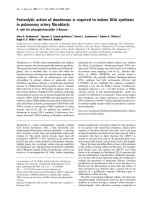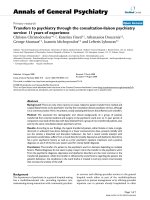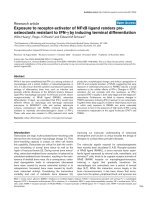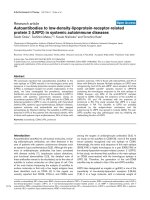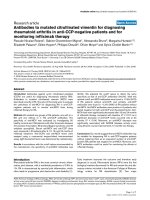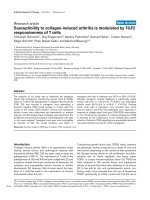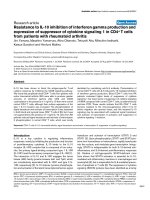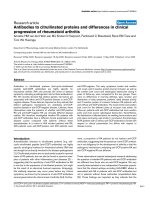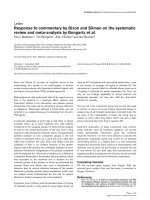Báo cáo y học: "Back to Bermuda: how is science best served" pptx
Bạn đang xem bản rút gọn của tài liệu. Xem và tải ngay bản đầy đủ của tài liệu tại đây (49.34 KB, 3 trang )
Genome
BBiioollooggyy
2009,
1100::
105
Opinion
BBaacckk ttoo BBeerrmmuuddaa:: hhooww iiss sscciieennccee bbeesstt sseerrvveedd??
Deanna M Church
*
and LaDeana W Hillier
†
Addresses:
*
NCBI/NLM/NIH 8600 Rockville Pike, Bethesda, MD 20894, USA.
†
Department of Genome Sciences, University of Washington,
1705 NE Pacific Street, Seattle, WA 98195, USA.
Correspondence: Deanna Church. Email:
Published: 24 April 2009
Genome
BBiioollooggyy
2009,
1100::
105 (doi:10.1186/gb-2009-10-4-105)
The electronic version of this article is the complete one and can be
found online at />© 2009 BioMed Central Ltd
It is not possible to overstate the impact that genome
sequencing and assembly has had on biomedical research.
While the release of a new genome assembly once spawned
worldwide press releases and announcements (in some cases
multiple times) there is now a general expectation that if you
are to do serious work on a model organism, a genome
assembly is a necessary part of the research plan. These
genome assemblies serve as the backbone for whole-genome
studies, comparative genomics and for research labs
performing locus-specific work. A critically important aspect
of the success of the Human Genome Project (HGP) was the
decision to immediately release pre-publication primary
sequence data [1]. This policy flew in the face of tradition,
especially in the community of those researching aspects of
the human genome, which stated that genome sequence
need only be made available upon publication. Although
there was some concern that this would jeopardize the
genome center’s ability to analyze and publish the data they
had produced, most involved felt that the benefit of early
release outweighed the risks of an outside group publishing
a genome assembly and analysis before the data producers.
Guidelines for both the release and use of these data were
published in what are commonly referred to as the Bermuda
principles and the Fort Lauderdale agreement [2]. While the
Bermuda principles have been incredibly valuable to the
research community, they were established more than 10
years ago, and it is time to revisit them as sequencing
technologies, standards and expectations are evolving at a
rapid pace.
The necessity to revisit these guidelines is underscored by
the simultaneous publication of two different assemblies of
the cow genome: Btau 4.0 as described by the Bovine
Genome Sequencing and Analysis Consortium (BGSAC) [3],
and UMD 2.0 as described by Zimin et al. [4]. Both these
genome assemblies are based on sequence traces generated
by the Baylor College of Medicine as a part of the BGSAC.
While the Zimin et al. publication does not violate the Fort
Lauderdale agreement as both genomes are being published
simultaneously, the availability of two genome assemblies
produced from the same dataset raises a series of questions
that will need to be addressed by funding agencies, sequence
producers and the user community. How many assemblies
are necessary and useful? Who has the right to perform the
genome assembly? How should the community select
reference assemblies? Are genome centers responsible for
assembly updates forever?
Many users may be surprised that the same dataset would
produce two different assemblies. However, the process of
genome assembly is akin to putting together a 3 billion piece
jigsaw puzzle. Of course, in the genome case many of the
pieces look almost identical and there may be multiple
correct solutions, depending on the data source. In addition
to polymorphisms and alternative haplotypes, other compli-
cations include the presence of segmental duplications,
defined as regions larger than 1 kb that have greater than
90% sequence identity with another region of the genome
[5], and large-scale structural variation, meaning that two
AAbbssttrraacctt
The independent announcements of two bovine genome assemblies from the same data suggest it is
time to revisit the spirit of the Bermuda and Fort Lauderdale agreements and determine the policies
for data release and distribution that will best serve both the producers of the data and the users.
chromosomes can differ by millions of base pairs or have
regional ordering differences [6]. Even the two most
complete and best studied mammalian genomes - human
and mouse - which were produced by clone-based rather
than whole-genome strategies, contain regions that remain
unassembled or that contain errors [7].
Genome centers put a great deal of effort into producing
high-quality sequence data and assemblies for the research
community and they deserve to have the chance to assemble
and analyze the data they produce. Although the effort
involved in producing a genome assembly has not decreased,
it is becoming increasingly difficult to get such work
published. There is a danger that the effort required to
perform the analysis required for publication in a top-tier
journal can significantly delay publication of the genome.
Whereas the assembly is typically available before publi-
cation, the inability of an outside group to publish a genome-
wide analysis of an assembly before its publication can
hinder the advancement of science. In other cases, there may
be a substantial delay between the production of sequence
reads and the production of the genome assembly. It is quite
clear that the research community is not well served in these
cases. It would be useful for the stakeholders to establish
timelines by which such assembly and publication mile-
stones should be reached.
A number of assembly programs are currently available but
none produces a base-perfect assembly with data from
current technologies. The shift from clone-based sequence to
whole-genome sequencing and assembly (WGSA) means
that the most highly duplicated, lineage-specific regions of
the genome are poorly represented in the final assembly [8],
but the way these regions are handled will vary with the
assembly package. Because of complications like those
described above, as well as the incomplete and non-uniform
representation of the sequence in whole-genome sequencing
datasets, even with a single assembly tool typically there are
multiple possible solutions to any given assembly that are
each completely consistent with the underlying data. Several
projects have taken advantage of the fact that multiple
assemblers exist and have produced multiple genome
assemblies as a part of the project. For example, during the
WGSA phase of the mouse genome projects, three rounds of
assemblies were performed using two different genome
assemblers (Arachne [9] and Phusion [10]). Both these
assemblies were made available during the early stages of
the project, but one was ultimately chosen for analysis and
publication. A similar approach was taken for both the
chimpanzee genome project [11] and the rhesus macaque
genome project [12]. The availability of multiple algorithms
and assemblies during the course of these projects improved
the final product immensely. In all these projects the final
assembly was made better because the different groups
performing the assembly worked with the genome center
responsible for the sequence data.
Everyone benefits if multiple assemblies are produced and
compared. Statistics such as chromosome length and
scaffold N50 (a measure of continuity that is defined as the
scaffold length for which 50% of the bases in an assembly
reside), although poor measures of base-level quality or
global assembly correctness, are often taken into account
when assessing assemblies. More importantly, comparison
of the genome sequence to independently derived sequences,
such as transcript collections or regions already finished
using clone-based sequencing, has also proved an effective
way to assess the quality of an assembly. Recently, additional
approaches that look for inconsistencies in the assembled
data have been described [13].
But despite the ability to perform many levels of analysis,
there are typically no set metrics for determining which
assembly should be deemed the reference. As different
genomes have different biological characteristics and
different levels of funding, it is difficult to establish a one-
size-fits-all policy. However, at the beginning of each project
it would be useful for all stakeholders to specify whether the
analysis of multiple assemblies is desired and to define how
any assemblies generated for the project will be measured.
The development of a third-party group, perhaps consisting
of representatives of the major annotator and browser
groups, could assist the centers in the quality assessment
stage of the assessment. Making the data from such
assessments widely available, perhaps through the browsers,
would help the user community understand both the
positive aspects as well as the limitations of a given
assembly. While it is generally advantageous to release a
single assembly for a given dataset, there may be instances
where it is not possible to determine the one best assembly,
and in those cases it is better to release both.
There is an additional issue of assembly updates and
improvements. Users performing genome-wide analysis
want a single, stable coordinate system, whereas users
interested in a specific gene or region want the best possible
representation of that region. However, not all genome
assemblies are updated after the initial publication. In many
cases the centers no longer have funding to work on the
projects, but the community continues to rely on the data
and in many cases adds new data that could be used to
improve the assembly. The resources generated by these
large projects are too valuable to be allowed to lie fallow and
we must explore mechanisms that do not burden the
genome centers but enable the genome assembly to improve
as our understanding of the data and genome increase.
These may include continued funding to the center for the
project or the transfer of the assembly to a third party for
management and updates. This would be useful for the
community as well as for the centers initially involved [7].
The notion of having multiple assemblies raises additional
questions and underscores the need to develop better tools
/>Genome
BBiioollooggyy
2009, Volume 10, Issue 4, Article 105 Church and Hillier 105.2
Genome
BBiioollooggyy
2009,
1100::
105
for tracking, comparing and displaying genome-assembly
data. As sequencing costs drop, additional datasets and
assemblies will inevitably be produced. This is already the
case for humans, for whom three different genome
assemblies (the HGP public reference, Celera’s, and
Venter’s) are already available. The overhead of analyzing,
annotating and displaying genome sequences is considerable
but manageable. However, the problems of data display,
establishing stable coordinates for exchange and assembly
tracking are considerable.
The first problem is assembly management. Although most
assemblies are deposited in the International Nucleotide
Sequence Database Consortium (INSDC) databases, com-
monly referred to as GenBank/EMBL/DDBJ, this is not
sufficient for tracking the actual assembly, only the
individual sequences associated with it. Currently, most
assemblies are tracked by name and date, with no formal
detailed notation of individual sequence changes. Tools for
formally managing and tracking genome assemblies are
currently in development, but they will only be the first step
to the suite of tools that need to be developed for managing
assemblies. There have been three updates to the human
genome since the publication describing the ‘finished’
genome [14] and simply specifying that a feature is on
human chromosome 1 at 10,000 base pairs is not sufficient
to uniquely identify that base.
In addition to improved tools for tracking and managing
assembly data, additional tools for comparing and displaying
multiple assemblies need to be developed. Currently,
Ensembl and the University of California Santa Cruz genome
browser can only annotate and display a single current
assembly within a given view, although archival versions of
the reference assemblies are available. The National Center
for Biotechnology Information has long supported the ability
to annotate and display multiple assemblies for a given
organism, but the book-keeping and user interface need
improvement. Tools based on aligning assemblies and
displaying comparative annotation are necessary to help
most users navigate these data. In addition, tools for rapidly
identifying assembly differences will be critical for honing in
on regions that should be judged skeptically and may need
manual intervention for improvement.
The sequencing of the human genome did not mark the end
of sequencing, but merely the beginning. Sequence data are
now easier to produce, but decisions about timelines for data
release, publication, and ownership and standards for
assembly comparison and quality assessment, as well as the
tools for managing and displaying these data, need
considerable attention in order to best serve the entire
community.
RReeffeerreenncceess
1.
ggeennoommee ggoovv || PPoolliiccyy oonn RReelleeaassee ooff HHuummaann GGeennoommiicc SSeeqquueennccee DDaattaa
((22000000))
[ />2.
ggeennoommee ggoovv || FFeebbrruuaarryy 22000033 DDaattaa RReelleeaassee PPoolliicciieess
[http://www.
genome.gov/10506537]
3. The Bovine Genome Sequencing and Analysis Consortium, Elsik CG,
Tellam RL, Worley KC:
TThhee ggeennoommee sseeqquueennccee ooff ttaauurriinnee ccaattttllee:: aa
wwiinnddooww ttoo rruummiinnaanntt bbiioollooggyy aanndd eevvoolluuttiioonn
Science
,
332244::
522-528.
4. Zimin AV, Delcher AL, Florea L, Kelley DA, Schatz MC, Puiu D, Han-
rahan F, Pertea G, Van Tassell CP, Sonstegard TS, Marcais G,
Roberts M, Subramanian P, Yorke JA, Salzberg SL:
AA wwhhoollee ggeennoommee
aasssseemmbbllyy ooff tthhee ddoommeessttiicc ccooww,,
BBooss ttaauurruuss
Genome Biol
2009,
1100::
r42.
5. Bailey JA, Eichler EE:
PPrriimmaattee sseeggmmeennttaall dduupplliiccaattiioonnss:: ccrruucciibblleess ooff
eevvoolluuttiioonn,, ddiivveerrssiittyy aanndd ddiisseeaassee
Nat Rev Genet
2006,
77
:552-564.
6. Sharp AJ, Cheng Z, Eichler EE:
SSttrruuccttuurraall vvaarriiaattiioonn ooff tthhee hhuummaann
ggeennoommee
Annu Rev Genomics Hum Genet
2006,
77
:407-442.
7.
GGeennoommee RReeffeerreennccee CCoonnssoorrttiiuumm
[ />jects/genome/assembly/grc/]
8. She X, Jiang Z, Clark RA, Liu G, Cheng Z, Tuzun E, Church DM,
Sutton G, Halpern AL, Eichler EE:
SShhoottgguunn sseeqquueennccee aasssseemmbbllyy aanndd
rreecceenntt sseeggmmeennttaall dduupplliiccaattiioonnss wwiitthhiinn tthhee hhuummaann ggeennoommee
Nature
2004,
443311::
927-930.
9. Batzoglou S, Jaffe DB, Stanley K, Butler J, Gnerre S, Mauceli E, Berger
B, Mesirov JP, Lander ES:
AARRAACCHHNNEE:: aa wwhhoollee ggeennoommee sshhoottgguunn
aasssseemmbblleerr
Genome Res
2002,
1122::
177-189.
10. Mullikin JC, Ning Z:
TThhee pphhuussiioonn aasssseemmbblleerr
Genome Res
2003,
1133
:
81-89.
11. The Chimpanzee Genome Sequencing Consortium:
IInniittiiaall sseeqquueennccee ooff
tthhee cchhiimmppaannzzeeee ggeennoommee aanndd ccoommppaarriissoonn wwiitthh tthhee hhuummaann ggeennoommee
Nature
2005,
443377::
69-87.
12. Gibbs RA, Rogers J, Katze MG, Bumgarner R, Weinstock GM,
Mardis ER, Remington KA, Strausberg RL, Venter JC, Wilson RK,
Batzer MA, Bustamante CD, Eichler EE, Hahn MW, Hardison RC,
Makova KD, Miller W, Milosavljevic A, Palermo RE, Siepel A, Sikela
JM, Attaway T, Bell S, Bernard KE, Buhay CJ, Chandrabose MN, Dao
M, Davis C, Delehaunty KD, Ding Y,
et al.
:
EEvvoolluuttiioonnaarryy aanndd bbiioommeedd
iiccaall iinnssiigghhttss ffrroomm tthhee rrhheessuuss mmaaccaaqquuee ggeennoommee
.
Science
2007,
331166::
222-234.
13. Phillippy A, Schatz M, Pop M:
GGeennoommee aasssseemmbbllyy ffoorreennssiiccss:: ffiinnddiinngg tthhee
eelluussiivvee mmiiss aasssseemmbbllyy
Genome Biol
2008,
99::
R55.
14. International Human Genome Sequencing Consortium:
FFiinniisshhiinngg tthhee
eeuucchhrroommaattiicc sseeqquueennccee ooff tthhee hhuummaann ggeennoommee
Nature
2004,
443311::
931-945.
/>Genome
BBiioollooggyy
2009, Volume 10, Issue 4, Article 105 Church and Hillier 105.3
Genome
BBiioollooggyy
2009,
1100::
105
BBoovviinnee ggeennoommee ccoovveerraaggee iinn BBiiooMMeedd CCeennttrraall::
• Burt DW:
TThhee ccaattttllee ggeennoommee rreevveeaallss iittss sseeccrreettss
J Biol
2009,
88::
36.
• Capuco AV, Akers RM:
TThhee oorriiggiinn aanndd eevvoolluuttiioonn ooff llaaccttaattiioonn
J Biol
2009,
88::
37.
• Church DM, Hillier LW:
BBaacckk ttoo BBeerrmmuuddaa:: hhooww iiss sscciieennccee bbeesstt
sseerrvveedd??
Genome Biol
2009,
1100::
105.
